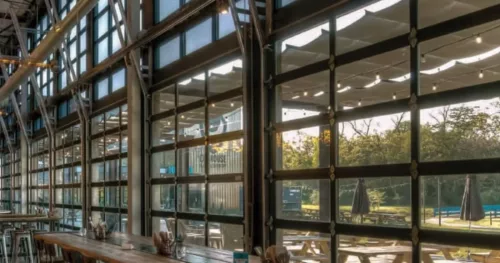In today’s world, sustainability is more than just a buzzword—it’s a necessity. Businesses across industries are searching for ways to reduce their carbon footprint and operate more efficiently. One of the most effective strategies is investing in sustainable storefronts. By upgrading to energy-efficient glass storefronts, you can not only let natural light flood your space but also significantly reduce your energy costs. This guide will explore the benefits of sustainable storefronts, focusing on insulation, solar control, and overall building performance.
The Rise of Sustainable Storefronts
As consumers become more environmentally conscious, businesses are under pressure to follow suit. Sustainable practices are no longer just good PR—they’re essential for staying competitive. One of the key elements of a sustainable storefront is energy-efficient glass, which offers a host of benefits, from improved insulation to enhanced aesthetics.
Imagine walking by a retail store with large, clear windows that showcase the merchandise inside, bathed in natural light. Not only does this create an inviting atmosphere, but it also reduces the need for artificial lighting during the day. This simple change can lead to significant energy savings over time, making it an attractive option for businesses looking to cut costs while going green.
Insulation and Energy Efficiency
Energy-efficient glass storefronts are designed to keep heat in during the winter and out during the summer, thanks to advanced insulation technologies. This is particularly important for businesses in regions with extreme weather conditions, where maintaining a comfortable indoor temperature can be costly.
1. Double and Triple Glazing
Double and triple glazing are common features in sustainable storefronts. These windows consist of two or three layers of glass with air or gas-filled spaces between them, which act as insulators. This design significantly reduces heat transfer, keeping your interior spaces warmer in the winter and cooler in the summer.
2. Low-E Coatings
Low-emissivity (Low-E) coatings are another crucial component of energy-efficient glass. These coatings reflect heat back into the building during the winter and block it from entering during the summer, further enhancing the insulation properties of your storefront. With Low-E glass, you can enjoy natural light without the accompanying heat gain or loss, making it a cornerstone of sustainable storefronts.
Solar Control for Comfort and Savings
In addition to insulation, solar control is a vital aspect of sustainable storefronts. Solar control glass is designed to reduce glare and block harmful UV rays, creating a more comfortable environment for customers and employees alike.
1. Solar Control Glass
Solar control glass reduces the amount of solar radiation that passes through the glass, minimizing the heat that enters the building. This is especially beneficial for storefronts with large windows or those that face the sun for extended periods. By controlling the amount of solar energy that enters your building, you can reduce your reliance on air conditioning, leading to lower energy bills.
2. UV Protection
UV protection is another important feature of solar control glass. Prolonged exposure to UV rays can cause fading and damage to merchandise, especially in retail environments where products are displayed near windows. Solar control glass blocks up to 99% of UV rays, protecting your inventory and enhancing the longevity of your products, which is a critical component of sustainable storefronts.
Enhancing Building Performance
Beyond energy savings, sustainable storefronts contribute to overall building performance. By reducing energy consumption, businesses can lower their operating costs and improve their bottom line. Additionally, energy-efficient glass can enhance the aesthetic appeal of your building, making it more attractive to customers and clients.
Increased Natural Light
One of the most significant benefits of glass storefronts is the increase in natural light. Natural light creates a welcoming atmosphere and can improve the mood and productivity of employees. In retail settings, it makes products look more appealing, which can boost sales. By designing your storefront to maximize natural light, you can create an inviting environment that attracts customers while reducing your energy usage.
Compliance with Green Building Standards
Investing in sustainable storefronts can also help your business comply with green building standards, such as LEED (Leadership in Energy and Environmental Design). These standards are becoming increasingly important in the commercial real estate market, and meeting them can increase the value of your property. Additionally, green building certification can enhance your brand image, showing customers that you are committed to sustainability.
Invest in Sustainable Storefronts Today
Incorporating sustainable storefronts into your business is a smart move for both the environment and your bottom line. By upgrading to energy-efficient glass, you can reduce your energy costs, enhance the comfort and aesthetics of your space, and demonstrate your commitment to sustainability.
Whether you’re planning a new build or retrofitting an existing space, the benefits of sustainable storefronts are clear. From improved insulation and solar control to better building performance and compliance with green standards, energy-efficient glass is an investment that pays off in more ways than one.
For more information on how to create a sustainable storefront and explore our range of energy-efficient glass options, visit Radford Garage Doors and Gates. Our experts are here to help you make the best choices for your business.






San Diego:
9185 Chesapeake Dr.
San Diego, CA 92123
(858) 925-2700
Mission Viejo:
27281 Las Ramblas, Suite 200,
Mission Viejo, CA 92691
(949) 749-7665
Email:
info@radforddoors.com
Google Rating
4.9